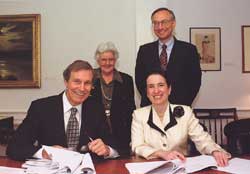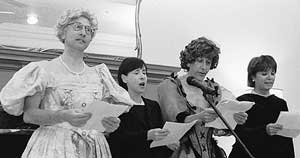![]()
Main Menu ·
Search ·
Current Issue · Contact · Archives · Centennial · Letters to the Editor · FAQs
![]()
Main Menu ·
Search ·
Current Issue · Contact · Archives · Centennial · Letters to the Editor · FAQs

The new signs at the entrances to Radcliffe Yard declare it the home of the Radcliffe Institute for Advanced Study, not Radcliffe College. There are new letterheads and new titles: the institute has deans, not vice presidents. A redesigned Radcliffe website no longer features undergraduate education. Such are the cosmetic signs of a far deeper change: as of October 1, the merger of Radcliffe College and Harvard University became official, and the Radcliffe Institute began its fledgling life. The merger, announced in April, was originally projected to be complete by July. Instead, it took several months to negotiate the legalities and details. The final agreement, now in place, provides a framework for change and growth as well as at least one major surprise.
Yet signed documents cannot settle the core identity question that will affect every major decision for the next few years of the institute's life: how to strike a balance between its mandate to foster "advanced study" in a wide-ranging sense, and another mandate: to promote the study of women, gender, and society. "That will be the question, and it will take years to resolve," says associate provost Dennis Thompson, who participated in the negotiations. For Jeremy Knowles, dean of the Faculty of Arts and Sciences, the central issue is to ensure that the institute has "an intellectual scope commensurate with its size. If it had an endowment of $30 million, an exclusive focus on women and gender studies might be appropriate. With a $300-million endowment, we are on a different scale." He notes that the Institute for Advanced Study in Princeton, New Jersey, whose endowment is valued at $380 million, supports scholars in many varied fields of study.
 Done deal: Neil L. Rudenstine, Mary Maples Dunn, Nancy-Beth Sheerr, and Harvey V. Fineberg at the September 14 signing of the final merger agreement. Photograph by Jon Chase |
The merger agreement requires that the Radcliffe Institute "sustain a continuing commitment" to the study of women, gender, and society. In this sense it offers a partial mission statement, making the institute unique among Harvard's faculties, none of which has a legally described limitation on its scholarly vista. Fifty years hence, if the University has failed to sustain this commitment to women, gender, and society, "Harvard would be in breach of the merger agreement," says Knowles.
The most important factor in shaping the institute's nascent identity will be the choice of its first dean, whose stature will equal that of the deans of Harvard's nine faculties. "That person will have extraordinary freedom to shape the programs," says Knowles. President Neil L. Rudenstine will appoint the dean, who is expected to be in place by next fall. In making the appointment, Rudenstine is consulting knowledgeable sources outside the University and also conferring with a select group of about 15 Harvard faculty members whom he has invited to contribute to the process.
The merger agreement requires that Rudenstine's choice be approved by a special committee consisting of four members from the former Radcliffe Board of Trustees (which dissolved on October 1) and four members of Harvard's governing boards. The Radcliffe representatives are Nancy-Beth Sheerr '71, who chaired the Radcliffe board and took a central role in the merger negotiations; Jeffrey Jones, J.D. '73, Radcliffe's lead lawyer in cutting the deal; Penny Noyce '77; and A'Leila Bundles '74, the new president of the Radcliffe College Alumnae Association (RCAA). Harvard Corporation fellows Hanna Gray, Ph.D. '57, and James Houghton '58 will join them, as will Joan Hutchins '61 and Charlotte Armstrong '49, LL.B. '53, current and past presidents of the Board of Overseers, respectively. These six women and two men will be joined by Rudenstine and Mary Maples Dunn, interim dean of the Radcliffe Institute, both seated as nonvoting members. Dunn characterizes this group of 10 as having an "advise and consent" function. It will consider various aspects of the institute's set-up in addition to the decanal appointment.
Surprisingly, the merger agreement reserves for the Radcliffe Institute an exclusive right to solicit donations from Radcliffe alumnae who graduated prior to 1976. During the summer's negotiations, "This was the issue where the difference was greatest and where there was the least movement," says Dennis Thompson. Leah McIntosh, director of development for the Faculty of Arts and Sciences, says that Radcliffe's development staff "feels they have a particular expertise with fundraising among women and would like to continue with that mold, using their already established relationships." Dunn explains that the transition "is for many people destabilizing. For the [Radcliffe] fundraisers, the potential loss of this exclusive privilege was frightening. I was in favor of continuing it in the short term as a transition measure. It is entirely up to the first dean to decide if she wishes to continue the pre-1976 exclusivity or to make other arrangements."
 Harvard transformed? On September 26, University provost Harvey Fineberg, Radcliffe trustee Susan S. Wallach '68, dean of the Faculty of Arts and Sciences Jeremy R. Knowles, and trustee Marianne Williams Tobias '62 joined in a Gilbert-and-Sullivan-inspired number celebrating the merger and the birth of the Radcliffe Institute. Photograph by Sarah Henrickson/Harvard Crimson |
New arrangements will also affect female undergraduates. Title IX, the federal statute that prohibits sex discrimination in education, exempts single-sex colleges. That exemption vanishes with Radcliffe College; now, women-only organizations like the Radcliffe Union of Students (RUS) are illegal. The newly created Ann Radcliffe Trust, administered by assistant dean of Harvard College Karen Avery '87 and modeled in part on the Harvard Foundation for Intercultural and Race Relations, will henceforth give grants to fund many of the undergraduate programs that RUS has sponsored in the past. Animated discussions continue about the Fay Prize, the prestigious award long given to an outstanding Radcliffe senior. The Fay's tradition involves both intellectual and emotional ties to the theme of female excellence, yet Title IX apparently prohibits Harvard College from limiting it to women. "As a general principle, Harvard's policy is that all programs and opportunities are open to all students, regardless of gender, race, and other similar characteristics unrelated to talent and ability," says Harry Lewis, dean of Harvard College. "The only exceptions that I can think of are athletic teams and choral singing groups, and from the standpoint of the law, both of those are specifically excepted from Title IX. The general Harvard standard is actually stricter than Title IX, since we don't allow all-male fraternities, for example, as the law would permit."
In a few years, the College may face an even knottier dilemma when its leases expire on Agassiz House, whose stage is home to many undergraduate theatricals, and Byerly Hall, which houses financial-aid and admissions offices for both the College and the Graduate School of Arts and Sciences. "The institute will very much want that building [Byerly] as a fellows center," says Dunn, who envisions the Bunting Institute (currently housed on Concord Avenue) moving into Radcliffe Yard. The new infusion of money from Harvard should enable the Bunting to fund all its fellows fully--a significant change from the status quo; in 1999-2000 only 20 of 38 Bunting fellows received full support.
Without making any major commitments, Dunn hopes to have several things in place and running by the time the new dean arrives a year hence. This spring, the Radcliffe Institute will sponsor a symposium on "gender and inquiry," and another on aesthetics a year later. Dunn plans to kick off a major lecture series in the fall of 2000, and is accordingly assembling a list of what she smilingly calls "luminaries" to invite. She would also like to bring a small number of "senior fellows," perhaps organized around a theme, to the institute for two-year appointments. These small early steps begin what will surely prove a long process of self-definition for the newest arrival in Cambridge: the Radcliffe Institute, a big, healthy infant with a decidedly feminine look.
Main Menu ·
Search · Current Issue · Contact · Archives · Centennial · Letters to the Editor · FAQs
![]()